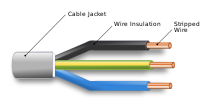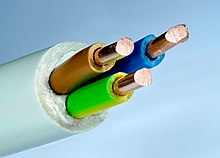Electrical cable
Etymology and Evolution of Cables:
- The term ‘cable’ originated from armoured submarine telegraph cables in the mid-19th century.
- Armouring was initially done by wire rope manufacturing specialists.
- The term expanded to encompass any bundle of electrical conductors enclosed in an outer sheath.
- It now includes telecommunications cables with fibre-optic cores.
- ‘Cable’ now encompasses various forms of electrical conductors.
Uses of Electrical Cables:
- Connecting devices for transferring electrical signals or power.
- Long-distance communication through undersea cables.
- Bulk transmission of alternating and direct current power using power cables.
- Building wiring for lighting, power, and control circuits.
- Cable assemblies comprising conductors, insulations, screens, and protective coverings.
Characteristics and Design Considerations:
- Current-carrying conductors radiate an electromagnetic field.
- Cables can pick up energy from existing electromagnetic fields.
- Cable length affects energy transmission and pickup.
- Shielding, coaxial geometry, and twisted-pair geometry minimize electromagnetic interference.
- Shielding in cables uses the Faraday cage principle to reduce external electrical fields.
Fire Protection and Safety Measures:
- Electrical cable jackets are typically made of flexible plastic that can burn.
- Grouped cables pose a fire hazard.
- Fire-resistant materials are used in high-reliability power cables.
- Proper cable management techniques can reduce fire risks.
- Fire tests assess the fire resistance of cable insulation.
Types of Cables and Hybrid Applications:
- 250 V, 16 A electrical cable on a reel.
- Coaxial cable for radio frequency signals.
- Direct-buried cable, flexible cables, and filled cables.
- Hybrid cables used in wireless outdoor fiber-to-the-antenna applications.
- Optical fibers for information transmission and electrical conductors for power transmission.
This article needs additional citations for verification. (September 2017) |
An electrical cable is an assembly of one or more wires running side by side or bundled, which is used as an electrical conductor, i.e., to carry electric current. One or more electrical cables and their corresponding connectors may be formed into a cable assembly, which is not necessarily suitable for connecting two devices but can be a partial product (e.g. to be soldered onto a printed circuit board with a connector mounted to the housing). Cable assemblies can also take the form of a cable tree or cable harness, used to connect many terminals together.


GD Garage Door Service MN • 651-373-0970
